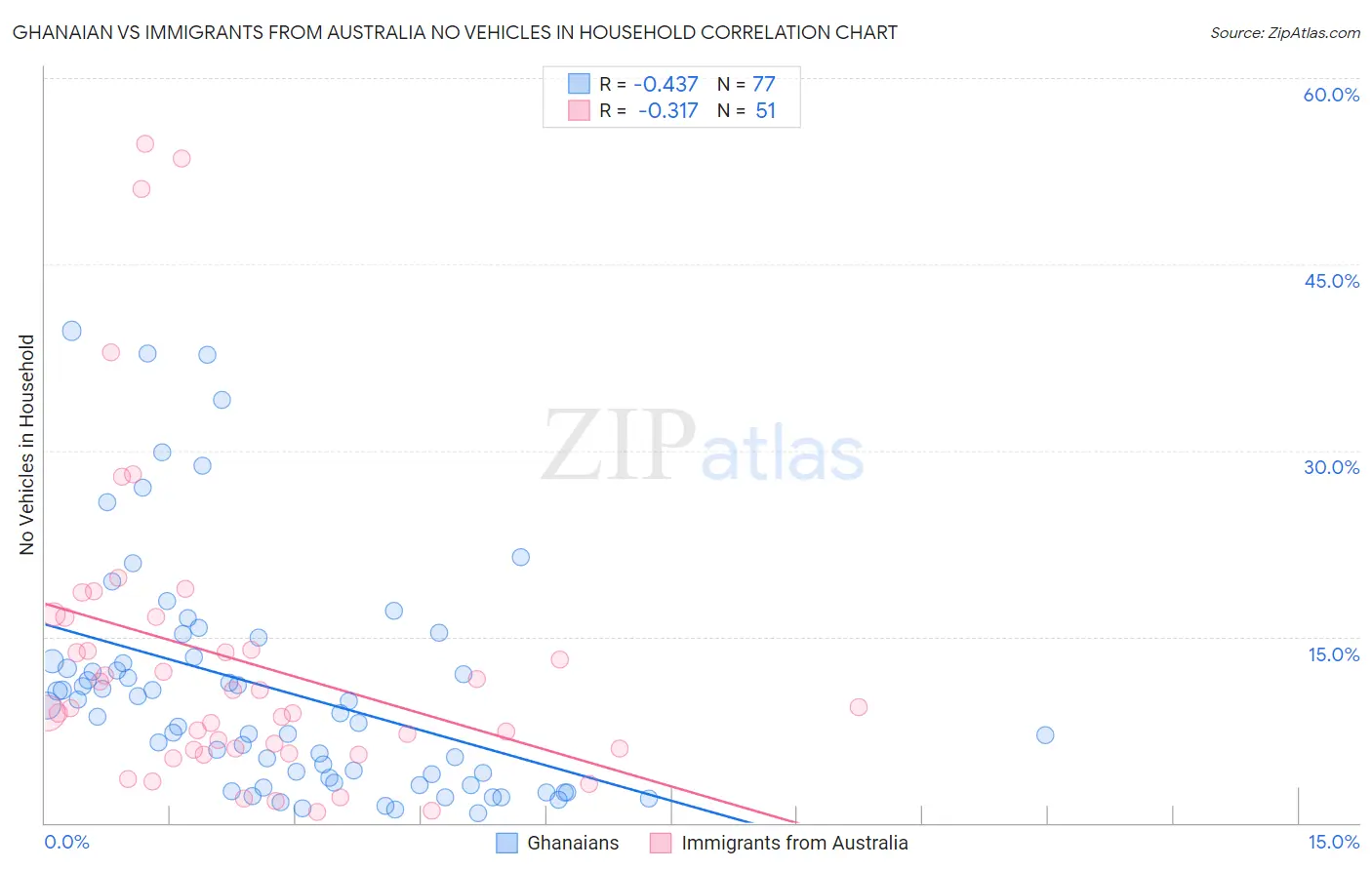Ghanaian vs Immigrants from Australia No Vehicles in Household
COMPARE
Ghanaian
Immigrants from Australia
No Vehicles in Household
No Vehicles in Household Comparison
Ghanaians
Immigrants from Australia
16.4%
NO VEHICLES IN HOUSEHOLD
0.0/ 100
METRIC RATING
316th/ 347
METRIC RANK
13.8%
NO VEHICLES IN HOUSEHOLD
0.0/ 100
METRIC RATING
289th/ 347
METRIC RANK
Ghanaian vs Immigrants from Australia No Vehicles in Household Correlation Chart
The statistical analysis conducted on geographies consisting of 190,166,774 people shows a moderate negative correlation between the proportion of Ghanaians and percentage of households with no vehicle available in the United States with a correlation coefficient (R) of -0.437 and weighted average of 16.4%. Similarly, the statistical analysis conducted on geographies consisting of 226,784,291 people shows a mild negative correlation between the proportion of Immigrants from Australia and percentage of households with no vehicle available in the United States with a correlation coefficient (R) of -0.317 and weighted average of 13.8%, a difference of 19.0%.

No Vehicles in Household Correlation Summary
| Measurement | Ghanaian | Immigrants from Australia |
| Minimum | 0.75% | 0.88% |
| Maximum | 39.6% | 54.7% |
| Range | 38.9% | 53.8% |
| Mean | 10.7% | 13.1% |
| Median | 8.9% | 9.3% |
| Interquartile 25% (IQ1) | 3.5% | 5.9% |
| Interquartile 75% (IQ3) | 13.2% | 16.6% |
| Interquartile Range (IQR) | 9.7% | 10.7% |
| Standard Deviation (Sample) | 9.2% | 12.4% |
| Standard Deviation (Population) | 9.2% | 12.3% |
Similar Demographics by No Vehicles in Household
Demographics Similar to Ghanaians by No Vehicles in Household
In terms of no vehicles in household, the demographic groups most similar to Ghanaians are Immigrants from Ghana (16.6%, a difference of 0.95%), Immigrants from Belarus (16.7%, a difference of 1.8%), Cypriot (15.7%, a difference of 5.0%), Albanian (15.6%, a difference of 5.1%), and Tohono O'odham (15.6%, a difference of 5.3%).
| Demographics | Rating | Rank | No Vehicles in Household |
| Puerto Ricans | 0.0 /100 | #309 | Tragic 15.5% |
| Cape Verdeans | 0.0 /100 | #310 | Tragic 15.6% |
| Immigrants | Israel | 0.0 /100 | #311 | Tragic 15.6% |
| Alaskan Athabascans | 0.0 /100 | #312 | Tragic 15.6% |
| Tohono O'odham | 0.0 /100 | #313 | Tragic 15.6% |
| Albanians | 0.0 /100 | #314 | Tragic 15.6% |
| Cypriots | 0.0 /100 | #315 | Tragic 15.7% |
| Ghanaians | 0.0 /100 | #316 | Tragic 16.4% |
| Immigrants | Ghana | 0.0 /100 | #317 | Tragic 16.6% |
| Immigrants | Belarus | 0.0 /100 | #318 | Tragic 16.7% |
| Alaska Natives | 0.0 /100 | #319 | Tragic 17.4% |
| Soviet Union | 0.0 /100 | #320 | Tragic 17.4% |
| Jamaicans | 0.0 /100 | #321 | Tragic 17.9% |
| Immigrants | Cabo Verde | 0.0 /100 | #322 | Tragic 18.4% |
| Immigrants | Yemen | 0.0 /100 | #323 | Tragic 19.5% |
Demographics Similar to Immigrants from Australia by No Vehicles in Household
In terms of no vehicles in household, the demographic groups most similar to Immigrants from Australia are Hopi (13.7%, a difference of 0.66%), Immigrants from Ireland (13.7%, a difference of 0.80%), Colville (13.7%, a difference of 1.0%), Immigrants from Eastern Europe (13.6%, a difference of 1.7%), and Immigrants from Malaysia (13.6%, a difference of 1.7%).
| Demographics | Rating | Rank | No Vehicles in Household |
| Immigrants | Eastern Asia | 0.0 /100 | #282 | Tragic 13.5% |
| Immigrants | Kazakhstan | 0.0 /100 | #283 | Tragic 13.6% |
| Immigrants | Malaysia | 0.0 /100 | #284 | Tragic 13.6% |
| Immigrants | Eastern Europe | 0.0 /100 | #285 | Tragic 13.6% |
| Colville | 0.0 /100 | #286 | Tragic 13.7% |
| Immigrants | Ireland | 0.0 /100 | #287 | Tragic 13.7% |
| Hopi | 0.0 /100 | #288 | Tragic 13.7% |
| Immigrants | Australia | 0.0 /100 | #289 | Tragic 13.8% |
| Indians (Asian) | 0.0 /100 | #290 | Tragic 14.1% |
| Okinawans | 0.0 /100 | #291 | Tragic 14.1% |
| Pima | 0.0 /100 | #292 | Tragic 14.1% |
| Immigrants | Jamaica | 0.0 /100 | #293 | Tragic 14.2% |
| Belizeans | 0.0 /100 | #294 | Tragic 14.3% |
| Paraguayans | 0.0 /100 | #295 | Tragic 14.4% |
| Immigrants | Spain | 0.0 /100 | #296 | Tragic 14.5% |